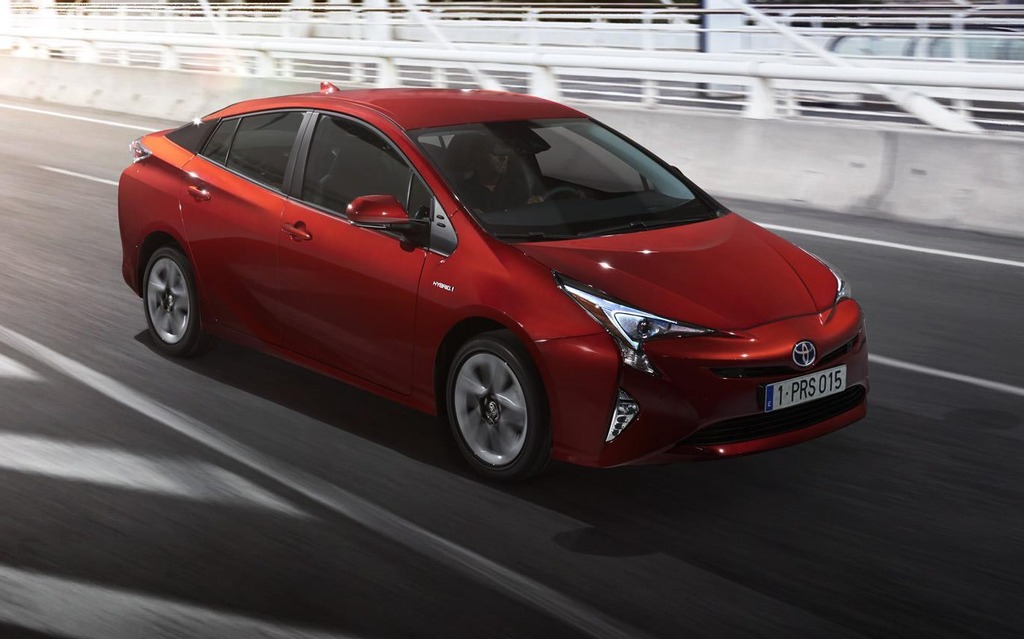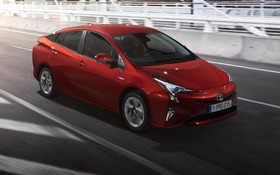2016 Toyota Prius: All That's Missing Is The Cord

| Strong points |
|
|---|---|
| Weak points |
|
Mount Fuji, Japan – If the new Toyota Prius that has rolled into dealerships has a fault, it's that it bucks current esthetic trends. It's very nice though—even elegant—with a style that differs considerably from the old Prius, which was distinctive, but a tad cartoonish. This newbie is 6 centimetres longer and stands out with a low-profile hood enhanced with smaller LED headlamps.
This is a great starting point for the star of Toyota-Lexus’ hybrid family, which has welcomed 15 different models since the first Prius was released in 1997.
- Also: Toyota Recalls 625,000 Priuses Over Software Problem
- Also: Kia Niro Hybrid: Putting The Prius On Notice
A battery of engineers
Wondering what the deal is with the 2016 edition? We tested it at Toyota's Mount Fuji test track, under some pretty unusual conditions. We were joined by a battery (no pun intended) of engineers eager to answer each and every one of our questions.
The short acclimatization session didn’t really leave us time to do a proper assessment, but the experience was nonetheless very informative. In particular, it highlighted the new direction that the world’s number-one automaker is taking: they’re trading up conservatism for a more dynamic execution and driving experience. And that applies to its entire product line.
The letters TNGA stand for “Toyota New Global Architecture,” which pretty much says it all about this latest initiative, and Toyota’s new platform is being inaugurated on the new Prius. Now 60% more rigid, you can really feel the difference in its handling and balance when cornering. There’s no body roll or pitching, and the vehicle has a livelier look than before without sacrificing comfort. Quick changes in direction don't hinder stability too much and only poor grip combined with excessive speed could cause you to lose control.
10% better under the hood
The 1.8-litre Atkinson cycle engine is no slouch either, thanks to increased thermal efficiency (40% more efficient) and greater energy density. Note that Toyota significantly reduced the weight of the various engine components. Although we weren’t given the exact figures on the power or fuel economy for the new drivetrain, we figure both are about 10% better. The complete technical specifications won't be available until after the end of the embargo on the Prius, which is expected to be on November 18.
Asked about the top speed in all-electric mode, the engineer optimistically claimed that if you accelerate smoothly, you can reach 105 km/h, unlike the old version, which topped out at 70 km/h. Only a test drive in very favourable conditions will help us see if this is true.
The electric motor draws from a lithium-ion battery that’s housed under the rear bench, a move that freed up 56 litres of trunk space.
Safety everywhere
Inside, there's nothing spectacular to note other than the very comfortable seats. Toyota is swelling the ranks of automakers focused on vehicle security accessories. They even gave us a demonstration of the collision avoidance system which applies the brakes abruptly when a pedestrian or obstacle is detected in front of the vehicle. Add to that the lane departure alert, intelligent cruise control and various other gadgets that you see everywhere these days.
Despite the Prius' main purpose, which is to save fuel, the focus was on safety, not fuel economy, during the unveiling. The front end crumple zone has been reinforced, a characteristic that will be added throughout the Toyota line-up over the coming years.
Easier on the eyes, more dynamic, safer and more fuel efficient, the 2016 Toyota Prius is ready to win people over. It's a shame that the manufacturer didn't go the extra mile and offer a plug-in option to extend the electric range of the whole Prius line-up. After all, that’s what Chevrolet did with the Volt. The only thing the Prius is missing is a cord.











